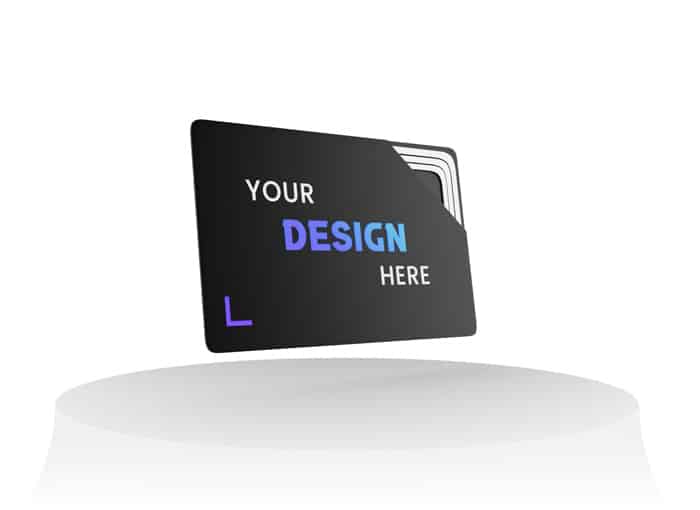
How can I get the most out of my business card?

In this article, we’ll take a look at what you need to bear in mind, and what you need to include on your business card, whether it’s a traditional card printed on cardboard, or a current card with a QR code and NFC chip.
Select and highlight relevant information
An image always speaks volumes, so don’t forget to include your company logo or a distinctive graphic that will immediately catch the eye.
It goes without saying that all your contact details should be included in a legible manner, highlighting your first and last name, job title, telephone number and e-mail address.
The general idea is that your interlocutor should be able to grasp the most important information at a glance: anything that stands in the way of understanding should be avoided, as it risks diminishing his or her commitment.
That’s why we don’t advise you to go for “exotic” business card formats or very special finishes like fish scales or lizard skin!
Go for a sober approach: there’s nothing to stop you breaking traditional codes a little, but it has to be kept in check, especially if your business is corporate or industrial.
Choose legible, high-quality typography
The first piece of advice is not to mix typefaces, as this gives a muddled, unprofessional image.
What’s more, it gives the impression of a lack of overall legibility.
A maximum of two fonts should be used on a business card: but if you choose to use just one, that’s even better!
To prioritize information, use different font sizes and bold what’s important.
Don’t forget that people who can’t see very well, so avoid using too small a font.
If a choice has to be made between the size of the illustration, the logo and the typeface, we suggest you give priority to the legibility of the information.
A graphic charter is not an option, but an obligation!
You may not be familiar with the term “graphic charter”, but it’s an essential part of professional communication.
It’s everything that makes your company unique in terms of document presentation, logo, illustrations, icons, typography and even the space between characters!
In short, it’s a precise framework that must be respected for all documents relating to the company to which you belong.
In fact, your business card, whether printed on thick cardboard or made of soft plastic or metal, must respect the visual codes contained in the graphic charter.
If you have your business card designed by a professional, he or she will probably ask you to pass it on to him or her, so that the card is consistent with the rest of your communication documents.
Keep it simple!
Yes, this criterion is important: a visually overloaded business card risks giving the wrong impression and, above all, drowning out relevant information.
If you belong to a company, sobriety is preferable, as it’s appreciated in all circumstances: don’t try to attract attention with “out of the ordinary” creativity, unless, of course, you work in graphics, events or the arts!
These days, we can offer you business cards in relief or with 3D effects: don’t rush into it, but take your time to think about it, because while they may be very attractive at first glance, they may not turn out to be very usable in the end.
Remember: the more out-of-the-box a product is, the more eye-catching and attention-grabbing it will be, but the more likely it will fail to appeal.
And since your business card is, in a way, an extension of yourself and your company, you don’t want to “put off” your interlocutor unnecessarily.
The same goes for colors: don’t use too many: the aim is to brighten up your traditional or non-contact business card, not to share a work of art…
But be careful, a business card that catches the eye through the quality of its graphics and layout is to be preferred: we don’t recommend visual austerity, which can give a gloomy impression.
Recapture the spirit and uniqueness of your company
In a way, the business card can be seen as a tiny part of the company to which you belong. In this sense, it’s important that it reflects what makes the company special, its market segment and its activities.
From this point of view, in addition to the logo and name, a well-chosen illustration can add extra interest.
For example, if you work for an airline, several small photographs of airplanes could be relevant.
If you’re in the metal industry, a spectacular photograph of molten metal could add interest to your business card.
Or if you’re a flower wholesaler, a picture of a particularly well composed bouquet could be an asset: we’re less inclined to throw away a document when it’s very pleasing to the eye!
But you don’t have to insert a photograph representing reality, a pictogram can also be relevant: they can add a little touch of originality while providing precise information about your company’s main activity.
Choosing the right medium for your business card
Today’s business cards, whether traditional or digital, are no longer necessarily made from paper pulp.
It can be based on several types of plastic with different levels of flexibility, wood, bamboo and even metal.
And if you want a particularly luxurious finish, you can even have it gilded!
The finish also counts, since you can generally choose between matte, satin or gloss.
You can also have it laminated to protect it from water and dirt.
Beware, however, that with a gloss finish or “soft touch” lamination, it will be difficult if not impossible to write information with a pen: the ink won’t be absorbed.
Paper weight should also be taken into account when designing your business card.
The rule is simple: the thicker the paper, i.e. weighing more than 300 g per square meter, the better the business card’s impression.
If you want to give an image of seriousness and commitment, this is a point you need to integrate before you start printing.
Finally, studies show that a “matt” lamination is more elegant than a “gloss” finish: the latter has the advantage of enhancing the vividness of the colors, but gives a less “high-end” appearance.
Why not opt for a connected business card with NFC chip?
To stand out from your competitors, choosing a contactless business card with a QR code and NFC chip can make all the difference.
In fact, with the addition of this communicating chip, you can easily transmit your contact details to your interlocutor: simply place your digital business card on his or her smartphone and the contact directory will integrate your information.
It’s fast, secure and avoids unnecessary waste of paper: a good thing at a time when the protection of the environment and the rational use of natural resources are valued.
Finally, you can even add geolocation data to the NFC chip, so that your contact can easily find your company’s premises if he or she decides to visit.
And thanks to the QR code, even if the cell phone of the person you’re talking to is a bit old, a simple scan with the camera will give you easy access to your contact details.
Written by Camille BODET
The digital business card is a real ally for professionals wishing to promote their business effectively and instantly. In the...Lire la suite
VKARD is an innovative and effective solution to help all professionals stand out from the crowd and reinforce their brand...Lire la suite
If you prepare properly for a job interview, you'll have every chance of winning over the recruiter and getting the...Lire la suite
LinkedIn is a world-renowned business platform, and for good reason! Thanks to its many networking options, LinkedIn is the tool...Lire la suite
Find out how Leexi AI optimizes the management of videoconferences and business calls, saving time and improving efficiency.
In the professional sphere, it's vital to know how to convey certain strong values in order to stand out and...Lire la suite
Mastering the art of conversation is a real asset! By mastering the subtle art of conversation, you'll be able to...Lire la suite
Are you taking part in a trade event and want to do everything you can to make a good impression?...Lire la suite
CRM (Customer Relationship Management) represents a genuine corporate strategy for managing business contacts. This popular tool for professionals is in...Lire la suite
At a time when the professional world is in a perpetual state of competition, we might wonder what place altruism,...Lire la suite















